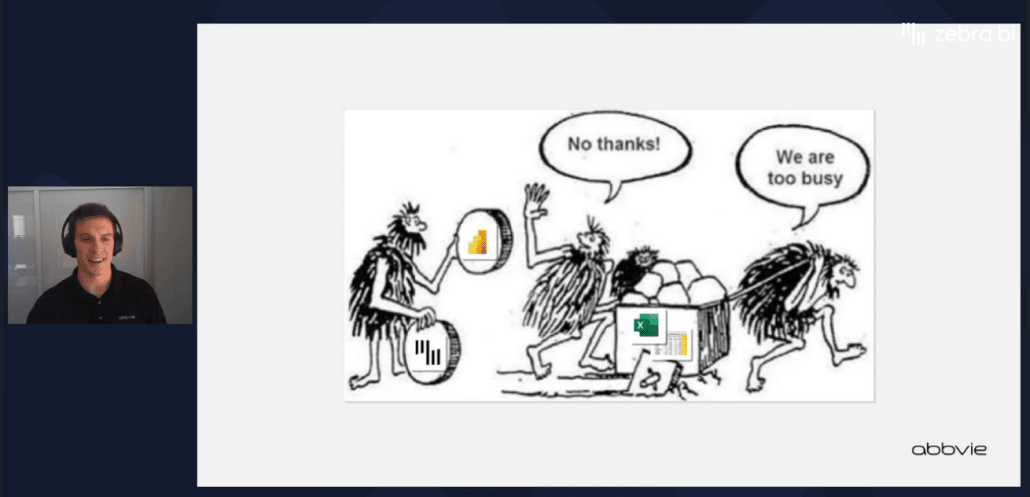
Busting 5 myths about internal Power BI adoption with Tyler Snyder from AbbVie
Driving internal adoption is in no way an easy task. It doesn't matter how awesome a solution you might bring to the table, your team still might need some time (and push) to adopt it.
There are plenty of things that need to fall into place when it comes to Power BI adoption. Getting sponsors and finding those early adopters, gaining trust and credibility, and more should be covered in order that the reports get adopted. Finally, people need to get inspired by your reports.
Like many of you, Tyler Snyder, Senior Financial Data Analyst at AbbVie also went through that process. He recently shared his story at ACTION 2022 and revealed five myths he used to believe when he first set out to create adoption, and he exposed the realities he learned through that path.
His session focused on the topic of internal adoption: what can people as individuals do on a micro level?
About Tyler Snyder, AbbVie, and his journey with Power BI

Tyler Snyder is a Senior Financial Data Analyst at AbbVie, and his Power BI experience first started about three years ago. At AbbVie, they had a problem simply that the data exceeded Excel's capacity and they were looking for how can they solve it within a global logistics trade: how can they find a way and the right tool to solve this?
This is how they finally stumbled across Power BI and at the same time, Zebra BI too.
Not only did Power BI solve the problem that they had, but it became a sustainable point where he would go back to it for other questions and a source of information to be the baseline for many other problems that would come forth.
Myth #1: Awareness is adoption
At the recent ACTION 2022, Tyler confessed that he used to think if he presented his ideas to 100 people, they were going to be just as excited as he was and they were going to want to immediately adopt them. But that wasn’t the case as awareness is about branding these ideas and sparking interest.
In contrast, adoption is much more individualized and tangible. It's other people actually using the outputs, in this case using the tools such as Power BI.

Adoption’s real focus should be on multiplying itself
Going from zero to 1000 in a matter of a month might be a little discouraging, so you should focus on that compounding multiplying effect and manage your expectations. Going from two to four, and then from four to eight, and so on: you're already doubling your impact! Hopefully, it gets even beyond your reach and it just starts taking a life of its own.
Although different from one another, awareness and adoption are both very valuable.
Awareness will help you find advocates and sponsors. If you present to a large audience, you'll likely have one or two people reach out after if they're interested, so you should take this opportunity, says Tyler. See how you can work together to actually grow that tangible piece.
Myth #2: the most important KPI is the number of users
In many companies, the first way we use to describe a good report is the number of its users. But firstly, Tyler emphasized that if we've learned anything about KPIs and reporting, is that we need context. For example, how did the result compare to our plan? How did it compare to our expenses?
The number of users may just measure the number of people who needed to see the information the report contained, not necessarily meaning that the report was good.
Before you start, you should know what your end goal is.
You could only have three users but if they took the report that you built and they made decisions of it that made value, you have reached your goal.
It doesn't matter how many people use your report, if the right people use it for an actionable way to create an impact in a positive manner for the company, focus on that.
Myth #3: If I keep promoting how my report solves somebody else's problems, I'll eventually win them over
Tyler Snyder shared his personal experience related to myth number 3: he says that sometimes he would be so excited about showing his report that he would be walking the end-users through his navigational path and he didn't create a space for them to speak up.
But eventually, he realized he wasn't right.
As you’re introducing a new tool and a new approach to solving their problem, you should settle down your own expectations and take interest in the end-user.
Is the report meeting their problem? Is this what they’re looking for, do they have any feedback to share?
It’s important to set the stage for users to speak up early and also help shape that output so they would be vested in it. If you do all that, you'll be in a good spot for it to be utilized when it gets to the endpoint.
Myth #4: There is a perfect idea out there to solve the adoption problem
As with most things, there's no magic pill out there.
But a better approach might be to focus on the problem statement. Tyler recommends you to ask yourself: what is the problem that you're looking to solve? Then you should focus to build harmony around that.
Instead of putting all your eggs in one basket with this one idea that you had that was supposed to change everything, you're now setting an environment where anyone can come forth with their own idea, and be inspired to see it through and carried out.
If you get harmony around the problem, you get buy-in around that. Ideas can organically sprout across the organization with various viewpoints and that's great!
Myth #5: Others taking credit for your ideas is bad
You might have a great idea for your company and you're not sharing it because you think someone else might take the credit or get it away from you. But if you aren't sharing your ideas, there'll be no credit to take for the idea that you're holding to yourself.
On top of that, when you share your ideas with others, they'll help refine them, and make them better, and more impactful. If they can take those ideas and feel like it's their own, they'll be much more inspired to carry them through.
There is a saying out there that the most sincere form of flattery is imitation.
There's also a well-known understanding amongst entrepreneurs and founders of companies. It's not the idea that's really what makes a business successful or a business that ends up ultimately failing.
It's how they execute that idea.
And if you're looking to add true value to your organization, if it's just one idea, find the value in executing on that because that is going to be more difficult than the ideas themselves.
Adoption path: how to start?
Tyler advises these next steps to make internal adoption more successful:
1. Start with a mission statement: what is the message that you're trying to get out there?
2. Promote awareness and share ideas
3. Bring people together: potential key sponsors or an analyst that would be an advocate for your idea
4. Repeat: go back to the mission statement and make it even better

Watch the full video session including Q&A from ACTION 2022
Watch this and many other how-to sessions from ACTION 2022, the only event dedicated to Actionable Reporting, and learn how experts from the world's leading companies create their reports.

 September 8th
September 8th February 22nd
February 22nd